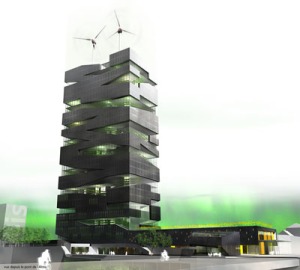
An architect's impression of a future Vertical Farm
The average European farm today does not really fit in our picture of a bright and green future. A modern farmer will have many items of machinery to work the land, consuming tonnes of fossil fuels and adding to the CO2 burden. In addition, the intensive farming practiced in the developed world depends on spreading the crops with pesticides and fertilisers. These take a great deal of energy to produce and are petroleum based. The run-off from these potions end up in our rivers, damaging fragile ecosystems. Much of our arable land has been laid to waste by irresponsible or over-intensive farming techniques. Food can travel thousands of miles to reach us, carrying with it a massive and messy carbon footprint.
So, what is the answer? One possibility being seriously considered is vertical farming. Still on paper rather than a reality, the indoor, multi storey, garden is intended for inner city food production. The food would be grown on your doorstep, largely eliminating emissions from transportation. As an intensive indoor growing space, traditional machinery would be obsolete, and the crops would require no chemical protection from the weather or disease. Vertical farming is the brainchild of Dr Dickson Despommier of Columbia University, who believes, along with a growing fan club, that vertical farms are an appealing alternative to traditional farming.
The farms could recycle waste water from cities; currently massive amounts of this are mixed with chlorine and dumped into our waterways. Instead it can be reprocessed and used to irrigate the crops. The farm could even produce drinking water. Electricity would come from the building’s integrated solar panels and wind turbines on the roof, making for a sustainable and eco-friendly farm.
Indoor farming is already a growing and successful business, with greenhouses constantly evolving their technology. Plants can be grown hydroponically in water, or in engineered soils. A method called aeroponics has been developed, where the plant grows dangling in a mist of water and nutrients.
Sceptics have noted that greenhouses often use a lot of electricity to create artificial light when the sun is not strong. They think that plants on lower levels of the vertical farm will require artificial lighting. However, with improving technology in solar panels, and solar tunnels which can channel light from the roof down, this problem may be surmountable.
Genetically modified plants would not be necessary; instead the indoor environment can be tailored to exactly produce the perfect growing environment for each crop.
The farms would help address another potential crisis. The global population is expected to boom by around 3 billion in the next 40 years. Using current farming practises, this would require a piece of land the size of Brazil devoted to more arable land. This much spare land simply does not exist.
According to research into humans living in extraterrestrial space, an estimated 300 sq feet of intensively farmed land will produce enough food to support one person. The vertical farmers have worked out that one of their projects, the size of a New York city block, at 30 stories high, would have enough space to produce food to support 10,000 people. Moving agriculture to these intensive sites would reduce the pressure on land being used for agriculture. This will allow for regeneration of land destroyed by farming, and provide breathing space for the development of sustainable practises to go along with the vertical farms. This might even go some way towards re-growth of the world’s rainforests.
The farms could be set up in countries already suffering from food shortages. Communities would not have to be at the mercy of the weather causing a bad harvest, and would be able to produce crops all year round. The plants would be at less risk of infectious disease as they would have little contact with life outside the farm. Supporters of the idea have even suggested setting up these farms in refugee camps, where food usually has to come from international aid, whose supplies may not be constant.
Clearly there are great reasons to go vertical when it comes to farming, but with any project there are obstacles along the way, and there are a few problems which might stop these farms from getting off the ground.
The development and building of the project is bound to be expensive, and the farms would have to be highly efficient to be an economically viable rival to conventional farming.
The buildings will be very complex affairs, housing irrigation systems for the plants, controlled indoor flow of air and nutrients, incinerators to contribute to energy supply, and water treatment apparatus. Taking the farm inside creates a host of complications. Maintenance would add to the expense, and the structure would be at risk from water damage, with the humid atmosphere and irrigation networks.
In promoting the idea, vertical farming supporters have suggested meat can be produced in these intensive environments; poultry and pigs could take up some of the levels of the building. More and more people are taking an ethical stance against intensive meat farming, so this could provoke some backlash.
Critics have suggested land in highly populated areas would be too expensive and hard to come by. Thankfully, Despommier has thought of a way around this obstacle. He remarks, ‘You can do this on the rooftops of hospitals and schools’, which would make use of the produce themselves, and he also suggests using outer suburbs of cities where land is cheaper.
The attractive features of vertical farming mean it has caught the interest of large developers, including multi-national firm Arup, who are looking to take the idea to the next level. City governments have contacted Despommier and his team, and there are talks to implement the farms into plans for entire eco-cities.
So maybe in the foreseeable future you will be buying superfresh produce from your local multi-storey farm.
Published in I, Science, Imperial College London’s student science journal, Autumn 2008